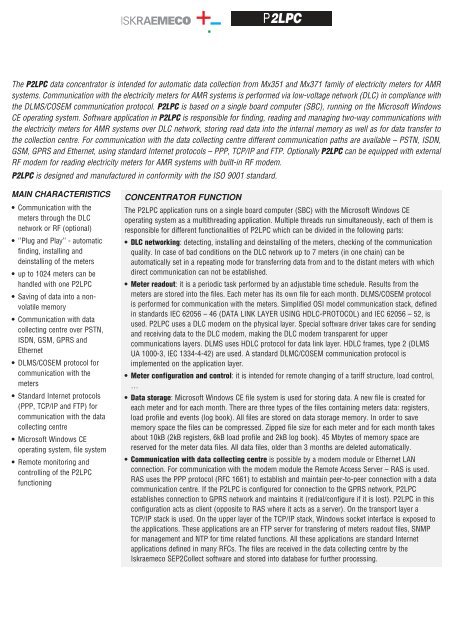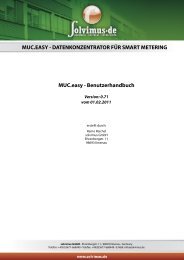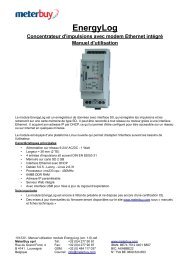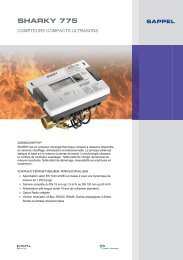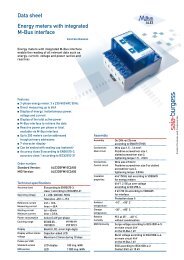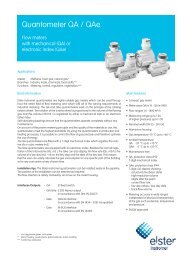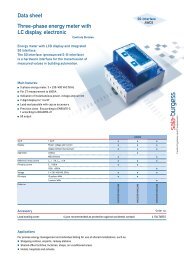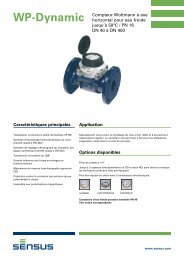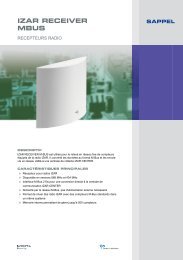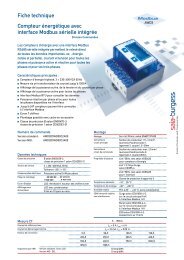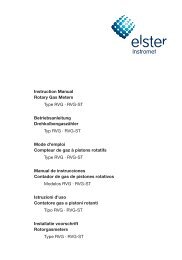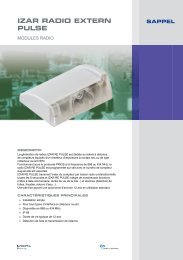P2LPC_prospect.pdf (ENG) - Iskraemeco
P2LPC_prospect.pdf (ENG) - Iskraemeco
P2LPC_prospect.pdf (ENG) - Iskraemeco
- No tags were found...
You also want an ePaper? Increase the reach of your titles
YUMPU automatically turns print PDFs into web optimized ePapers that Google loves.
<strong>P2LPC</strong>The <strong>P2LPC</strong> data concentrator is intended for automatic data collection from Mx351 and Mx371 family of electricity meters for AMRsystems. Communication with the electricity meters for AMR systems is performed via low-voltage network (DLC) in compliance withthe DLMS/COSEM communication protocol. <strong>P2LPC</strong> is based on a single board computer (SBC), running on the Microsoft WindowsCE operating system. Software application in <strong>P2LPC</strong> is responsible for finding, reading and managing two-way communications withthe electricity meters for AMR systems over DLC network, storing read data into the internal memory as well as for data transfer tothe collection centre. For communication with the data collecting centre different communication paths are available – PSTN, ISDN,GSM, GPRS and Ethernet, using standard Internet protocols – PPP, TCP/IP and FTP. Optionally <strong>P2LPC</strong> can be equipped with externalRF modem for reading electricity meters for AMR systems with built-in RF modem.<strong>P2LPC</strong> is designed and manufactured in conformity with the ISO 9001 standard.MAIN CHARACTERISTICS• Communication with themeters through the DLCnetwork or RF (optional)• ‘’Plug and Play’’ - automaticfinding, installing anddeinstalling of the meters• up to 1024 meters can behandled with one <strong>P2LPC</strong>• Saving of data into a nonvolatilememory• Communication with datacollecting centre over PSTN,ISDN, GSM, GPRS andEthernet• DLMS/COSEM protocol forcommunication with themeters• Standard Internet protocols(PPP, TCP/IP and FTP) forcommunication with the datacollecting centre• Microsoft Windows CEoperating system, file system• Remote monitoring andcontrolling of the <strong>P2LPC</strong>functioningCONCENTRATOR FUNCTIONThe <strong>P2LPC</strong> application runs on a single board computer (SBC) with the Microsoft Windows CEoperating system as a multithreading application. Multiple threads run simultaneously, each of them isresponsible for different functionalities of <strong>P2LPC</strong> which can be divided in the following parts:• DLC networking: detecting, installing and deinstalling of the meters, checking of the communicationquality. In case of bad conditions on the DLC network up to 7 meters (in one chain) can beautomatically set in a repeating mode for transferring data from and to the distant meters with whichdirect communication can not be established.• Meter readout: it is a periodic task performed by an adjustable time schedule. Results from themeters are stored into the files. Each meter has its own file for each month. DLMS/COSEM protocolis performed for communication with the meters. Simplified OSI model communication stack, definedin standards IEC 62056 – 46 (DATA LINK LAYER USING HDLC-PROTOCOL) and IEC 62056 – 52, isused. <strong>P2LPC</strong> uses a DLC modem on the physical layer. Special software driver takes care for sendingand receiving data to the DLC modem, making the DLC modem transparent for uppercommunications layers. DLMS uses HDLC protocol for data link layer. HDLC frames, type 2 (DLMSUA 1000-3, IEC 1334-4-42) are used. A standard DLMC/COSEM communication protocol isimplemented on the application layer.• Meter configuration and control: it is intended for remote changing of a tariff structure, load control,…• Data storage: Microsoft Windows CE file system is used for storing data. A new file is created foreach meter and for each month. There are three types of the files containing meters data: registers,load profile and events (log book). All files are stored on data storage memory. In order to savememory space the files can be compressed. Zipped file size for each meter and for each month takesabout 10kB (2kB registers, 6kB load profile and 2kB log book). 45 Mbytes of memory space arereserved for the meter data files. All data files, older than 3 months are deleted automatically.• Communication with data collecting centre is possible by a modem module or Ethernet LANconnection. For communication with the modem module the Remote Access Server – RAS is used.RAS uses the PPP protocol (RFC 1661) to establish and maintain peer-to-peer connection with a datacommunication centre. If the <strong>P2LPC</strong> is configured for connection to the GPRS network, <strong>P2LPC</strong>establishes connection to GPRS network and maintains it (redial/configure if it is lost). <strong>P2LPC</strong> in thisconfiguration acts as client (opposite to RAS where it acts as a server). On the transport layer aTCP/IP stack is used. On the upper layer of the TCP/IP stack, Windows socket interface is exposed tothe applications. These applications are an FTP server for transfering of meters readout files, SNMPfor management and NTP for time related functions. All these applications are standard Internetapplications defined in many RFCs. The files are received in the data collecting centre by the<strong>Iskraemeco</strong> SEP2Collect software and stored into database for further processing.


